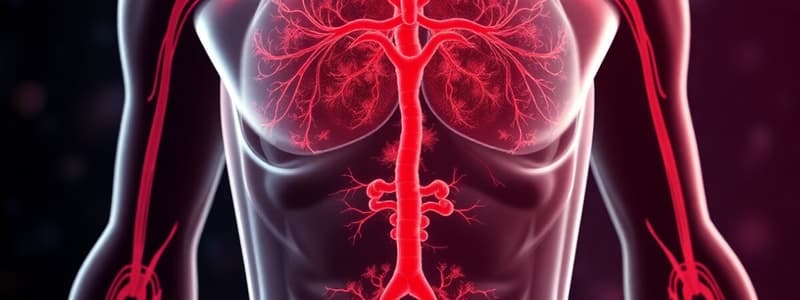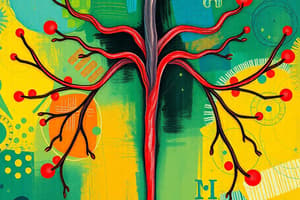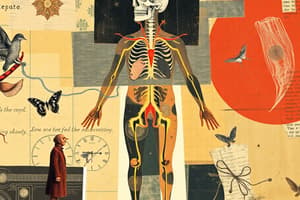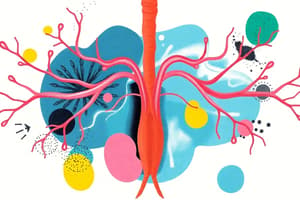Podcast
Questions and Answers
Which of the following is the most direct consequence of a frameshift mutation?
Which of the following is the most direct consequence of a frameshift mutation?
- A significantly altered protein sequence due to a change in the reading frame. (correct)
- A single amino acid in a protein being changed.
- The complete halting of DNA replication .
- The DNA sequence returning to its original state after a point mutation.
If a strand of DNA has the sequence 5'-AGTCGTCG-3', what is the sequence of the complementary strand?
If a strand of DNA has the sequence 5'-AGTCGTCG-3', what is the sequence of the complementary strand?
- 5'-TCGACGAC-3' (correct)
- 5'-GCTAGCTA-3'
- 5'-CGAUGCAU-3'
- 5'-TCAGCAGC-3'
How do vestigial genes provide evidence for evolution?
How do vestigial genes provide evidence for evolution?
- By demonstrating the presence of non-coding DNA.
- By indicating an organism's ability to adapt to new environmental conditions.
- By showing similarities in DNA sequences between different species.
- By representing remnants of genes that were functional in ancestral species but are no longer useful. (correct)
Which of the following correctly pairs a type of evolutionary evidence with its corresponding description?
Which of the following correctly pairs a type of evolutionary evidence with its corresponding description?
Besides the genetic information, what else does DNA structure provide and what is its role during cell division?
Besides the genetic information, what else does DNA structure provide and what is its role during cell division?
How do thyroid hormones primarily influence metabolic rate?
How do thyroid hormones primarily influence metabolic rate?
During a stressful event, which set of hormonal responses is most likely to occur due to adrenal gland activity?
During a stressful event, which set of hormonal responses is most likely to occur due to adrenal gland activity?
Which of the following represents an integrated function of both the thyroid and adrenal glands?
Which of the following represents an integrated function of both the thyroid and adrenal glands?
If the fallopian tubes were blocked, which process would be directly disrupted?
If the fallopian tubes were blocked, which process would be directly disrupted?
What physiological change primarily explains abdominal pain experienced during menstruation?
What physiological change primarily explains abdominal pain experienced during menstruation?
Which hormone is critical for initiating the development of ovarian follicles?
Which hormone is critical for initiating the development of ovarian follicles?
What is the primary purpose of negative feedback loops in maintaining homeostasis?
What is the primary purpose of negative feedback loops in maintaining homeostasis?
How does the nervous system contribute to maintaining homeostasis?
How does the nervous system contribute to maintaining homeostasis?
What is the primary role of baroreceptors in maintaining blood pressure homeostasis?
What is the primary role of baroreceptors in maintaining blood pressure homeostasis?
How does the brain respond to signals from osmoreceptors to maintain fluid balance?
How does the brain respond to signals from osmoreceptors to maintain fluid balance?
Which enzyme is responsible for unwinding the double-stranded DNA during replication?
Which enzyme is responsible for unwinding the double-stranded DNA during replication?
Which type of RNA carries genetic information from DNA to ribosomes for protein synthesis?
Which type of RNA carries genetic information from DNA to ribosomes for protein synthesis?
What type of mutation involves a single nucleotide substitution, insertion, or deletion?
What type of mutation involves a single nucleotide substitution, insertion, or deletion?
According to the central dogma, what is the correct flow of genetic information?
According to the central dogma, what is the correct flow of genetic information?
Which type of mutation does NOT typically affect the protein function?
Which type of mutation does NOT typically affect the protein function?
How does UV radiation primarily cause mutations in DNA?
How does UV radiation primarily cause mutations in DNA?
What is the main mechanism by which mutations lead to antibiotic resistance in bacteria?
What is the main mechanism by which mutations lead to antibiotic resistance in bacteria?
Why are transitional fossils considered important pieces of evidence for evolution?
Why are transitional fossils considered important pieces of evidence for evolution?
What is the key difference between homologous and analogous structures?
What is the key difference between homologous and analogous structures?
How does the sequence of nucleotides in DNA relate to the amino acid sequence in proteins?
How does the sequence of nucleotides in DNA relate to the amino acid sequence in proteins?
What does comparative embryology reveal about the evolutionary history of different species?
What does comparative embryology reveal about the evolutionary history of different species?
Which of the following enzymes synthesizes new DNA strands by adding nucleotides to the primers?
Which of the following enzymes synthesizes new DNA strands by adding nucleotides to the primers?
Which of the following seals the gaps between Okazaki fragments?
Which of the following seals the gaps between Okazaki fragments?
Which hormone directly stimulates the testes to produce testosterone during male puberty?
Which hormone directly stimulates the testes to produce testosterone during male puberty?
During pregnancy, which hormone is primarily responsible for maintaining the pregnancy by ensuring the continued production of progesterone?
During pregnancy, which hormone is primarily responsible for maintaining the pregnancy by ensuring the continued production of progesterone?
What is the primary role of oxytocin during lactation?
What is the primary role of oxytocin during lactation?
Which of the following describes the role of glucagon in regulating blood sugar levels?
Which of the following describes the role of glucagon in regulating blood sugar levels?
During which phase of the menstrual cycle does the uterine lining thicken in preparation for potential implantation?
During which phase of the menstrual cycle does the uterine lining thicken in preparation for potential implantation?
What is the direct trigger for the release of a mature egg from the ovary?
What is the direct trigger for the release of a mature egg from the ovary?
Which function does estrogen perform during pregnancy?
Which function does estrogen perform during pregnancy?
Which hormone is responsible for stimulating milk production in the breasts after childbirth?
Which hormone is responsible for stimulating milk production in the breasts after childbirth?
Which of the following hormones is NOT directly involved in male puberty?
Which of the following hormones is NOT directly involved in male puberty?
What is the primary function of progesterone during the luteal phase of the menstrual cycle?
What is the primary function of progesterone during the luteal phase of the menstrual cycle?
Which stage of the menstrual cycle involves the shedding of the uterine lining?
Which stage of the menstrual cycle involves the shedding of the uterine lining?
How does the body respond to insulin in individuals with type 2 diabetes?
How does the body respond to insulin in individuals with type 2 diabetes?
Which function is impaired in individuals with diabetes, leading to high blood sugar levels?
Which function is impaired in individuals with diabetes, leading to high blood sugar levels?
Besides hormonal imbalances, what is another potential cause of irregular menstrual periods?
Besides hormonal imbalances, what is another potential cause of irregular menstrual periods?
What is the role of Follicle-Stimulating Hormone (FSH) in males?
What is the role of Follicle-Stimulating Hormone (FSH) in males?
Flashcards
Thyroid Gland
Thyroid Gland
An endocrine gland regulating metabolism via hormones T3 and T4.
Thyroid Hormones
Thyroid Hormones
Triiodothyronine (T3) and thyroxine (T4) control calorie burning rates.
Adrenal Glands
Adrenal Glands
Glands that help the body respond to stress by producing hormones like cortisol and adrenaline.
Cortisol
Cortisol
Signup and view all the flashcards
Follicle-Stimulating Hormone (FSH)
Follicle-Stimulating Hormone (FSH)
Signup and view all the flashcards
Homeostasis
Homeostasis
Signup and view all the flashcards
Negative Feedback Mechanism
Negative Feedback Mechanism
Signup and view all the flashcards
Menstrual Cramps
Menstrual Cramps
Signup and view all the flashcards
Complementary Base Pairing
Complementary Base Pairing
Signup and view all the flashcards
Point Mutations
Point Mutations
Signup and view all the flashcards
Frameshift Mutations
Frameshift Mutations
Signup and view all the flashcards
Vestigial Genes
Vestigial Genes
Signup and view all the flashcards
Fossil Record
Fossil Record
Signup and view all the flashcards
Testosterone
Testosterone
Signup and view all the flashcards
Luteinizing Hormone (LH)
Luteinizing Hormone (LH)
Signup and view all the flashcards
Human Chorionic Gonadotropin (hCG)
Human Chorionic Gonadotropin (hCG)
Signup and view all the flashcards
Progesterone
Progesterone
Signup and view all the flashcards
Estrogen
Estrogen
Signup and view all the flashcards
Oxytocin
Oxytocin
Signup and view all the flashcards
Prolactin
Prolactin
Signup and view all the flashcards
Insulin
Insulin
Signup and view all the flashcards
Glucagon
Glucagon
Signup and view all the flashcards
Menstrual Cycle
Menstrual Cycle
Signup and view all the flashcards
Stages of Menstrual Cycle
Stages of Menstrual Cycle
Signup and view all the flashcards
Luteal Phase
Luteal Phase
Signup and view all the flashcards
Causes of Irregular Menstrual Period
Causes of Irregular Menstrual Period
Signup and view all the flashcards
Function of Progesterone in Menstrual Cycle
Function of Progesterone in Menstrual Cycle
Signup and view all the flashcards
Baroreceptors
Baroreceptors
Signup and view all the flashcards
Antidiuretic Hormone (ADH)
Antidiuretic Hormone (ADH)
Signup and view all the flashcards
Helicase
Helicase
Signup and view all the flashcards
mRNA
mRNA
Signup and view all the flashcards
Central Dogma
Central Dogma
Signup and view all the flashcards
Transitional Fossils
Transitional Fossils
Signup and view all the flashcards
Homologous Structures
Homologous Structures
Signup and view all the flashcards
Analogous Structures
Analogous Structures
Signup and view all the flashcards
UV Radiation Mutations
UV Radiation Mutations
Signup and view all the flashcards
Antibiotic Resistance
Antibiotic Resistance
Signup and view all the flashcards
Embryological Development
Embryological Development
Signup and view all the flashcards
Ligase
Ligase
Signup and view all the flashcards
rRNA
rRNA
Signup and view all the flashcards
Study Notes
Thyroid and Metabolism
- Thyroid gland regulates metabolism by controlling calorie burning rate.
- Key hormones: triiodothyronine (T3) and thyroxine (T4).
- These hormones stimulate nutrient breakdown and increase energy production.
Adrenal Glands and Stress Response
- Adrenal glands respond to stress.
- Hormones released in response to stress: cortisol, adrenaline (epinephrine), and noradrenaline (norepinephrine).
- Cortisol regulates blood sugar.
- Adrenaline and noradrenaline prepare the body for "fight or flight" (increased heart rate, blood pressure, energy).
Female Reproductive System
- Internal Parts: Ovaries (egg and hormone production), fallopian tubes (egg transport), uterus (fetal development), cervix (connects uterus to vagina).
- Fertilization: Occurs in the fallopian tubes.
- Menstrual Cycle and Pain: Uterine contractions during menstruation cause abdominal pain. Hormonal changes (progesterone drop) also contribute.
- Follicle Development: Follicle-stimulating hormone (FSH) stimulates follicle growth and maturation in the ovaries.
Homeostasis and Feedback Mechanisms
- Homeostasis: maintaining a stable internal environment.
- Feedback mechanisms (like negative feedback loops) regulate various bodily functions (e.g., temperature, blood sugar, hormone production).
Nervous System in Homeostasis
- Nervous system plays a critical role in maintaining homeostasis and regulating feedback mechanisms.
- It integrates sensory information and sends signals to effectors to maintain stability.
-
Blood Pressure: Baroreceptors detect blood pressure changes, and the brain adjusts the sympathetic/parasympathetic nervous system to maintain balance. -Effectors: blood vessels constrict/dilate, and heart rate changes.
-
Fluid Balance: Osmoreceptors detect blood osmolarity changes, and the brain stimulates ADH release for water homeostasis. -Effectors: kidneys adjust water reabsorption.
-
DNA Replication Enzymes
- Helicase: unwinds DNA.
- Primase: synthesizes RNA primers.
- DNA Polymerase: synthesizes new DNA strands.
- Ligase: seals gaps between DNA segments (Okazaki fragments).
Types of RNA
- mRNA (messenger RNA): Carries genetic information from DNA to ribosomes for protein synthesis.
- tRNA (transfer RNA): Brings amino acids to ribosomes.
- rRNA (ribosomal RNA): Forms ribosomes and plays a structural role in protein synthesis.
DNA Replication Errors
- Point mutations: single nucleotide changes (substitutions, insertions, deletions).
- Frameshift mutations: insertions or deletions changing the reading frame.
- Chromosomal mutations: changes in chromosome structure or number.
Central Dogma of Molecular Biology
- DNA → RNA → Protein
Types of Mutations and Effects
- Point mutations: silent, missense, or nonsense; affects protein function.
- Frameshift mutations: often result in nonfunctional proteins.
- Chromosomal mutations: can alter gene expression, cause cancer, or lead to birth defects.
UV Radiation and Mutations
- UV radiation damages DNA by forming pyrimidine dimers.
- Damaged DNA can trigger error-prone repair mechanisms during DNA repair, causing mutations.
- UV radiation directly alters DNA bases, leading to mutations.
Antibiotic Resistance
- Antibiotic resistance develops when bacteria mutate to resist antibiotics' effect.
- Mutations can alter the antibiotic's target, reducing its effectiveness (e.g., beta-lactamase resistance).
Fossils and Evolution
- Fossils document the chronology of life on Earth.
- Transitional fossils show characteristics of both ancestral and descendant species (e.g., Tiktaalik: fish to tetrapod).
Homologous vs. Analogous Structures
- Homologous structures: shared ancestry (e.g., vertebrate forelimbs - human arms, bird wings, whale flippers).
- Analogous structures: similar function evolved independently (e.g., bird wings and insect wings).
DNA/Amino Acid Sequence
- DNA sequence determines the amino acid sequence of proteins.
- Amino acid sequence forms the primary structure and subsequently determines protein shape and function.
Embryological Development
- Fertilized egg develops into a mature organism through cell division, differentiation, and morphogenesis.
- Comparative embryology unveils shared evolutionary history evidenced by similar embryonic structures in various vertebrate species (e.g., notochord, somites, pharyngeal arches).
Male Puberty Hormones
- Testosterone: Produced by testes, responsible for secondary sexual characteristics (hair, voice, muscle mass, genitals growth).
- Luteinizing Hormone (LH): Produced by pituitary gland, stimulates testosterone production.
- Follicle-Stimulating Hormone (FSH): Produced by pituitary gland, stimulates sperm development.
Pregnancy Hormones
- Human Chorionic Gonadotropin (hCG): Maintains pregnancy by stimulating progesterone production.
- Progesterone: Prepares uterus and supports embryonic development.
- Estrogen: Maintains pregnancy, stimulates uterine and breast growth, and prepares cervix for labor.
- Oxytocin: Stimulates uterine contractions and milk letdown.
Lactation Hormones
- Prolactin: Stimulates milk production.
- Oxytocin: Stimulates milk release.
Pancreas and Diabetes
- Pancreas: produces digestive enzymes and hormones (insulin, glucagon).
- Insulin: lowers blood sugar by facilitating glucose uptake.
- Glucagon: raises blood sugar by stimulating glycogen breakdown.
- Diabetes: occurs when the body cannot produce or use insulin effectively, resulting in high blood sugar.
Menstrual Cycle Stages
- Menstruation: Uterine lining shedding (Days 1-5).
- Follicular phase: Follicle growth (Days 6-14).
- Ovulation: Egg release (Day 14).
- Luteal phase: Uterine lining preparation (Days 15-28).
Ovulation Trigger
- Luteinizing hormone (LH) triggers ovulation.
Progesterone Function
- Progesterone: Thickens uterine lining for implantation and maintains pregnancy.
Irregular Menstrual Periods
- Causes: Hormonal imbalances, stress, weight changes, PCOS, thyroid disorders.
Complementary Base Pairing
- Nucleotides (A-T, G-C) pair to form DNA's double helix.
Mutations and Complementary Base Pairing
- Mutations (point, frameshift, chromosomal) occur during DNA replication or repair.
- Complementary base pairing safeguards the genetic code during DNA replication. DNA polymerase ensures accurate base pairing.
DNA Structure and Evolution
- DNA structure (universal genetic code, sequence similarities, vestigial genes) reflects evolutionary history.
Evidences of Evolution
- Fossil record, comparative anatomy, molecular biology (DNA/protein similarities), biogeography all support the theory of evolution.
Studying That Suits You
Use AI to generate personalized quizzes and flashcards to suit your learning preferences.




